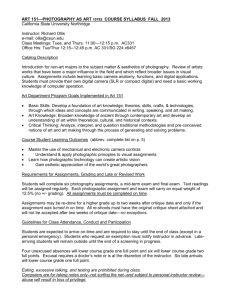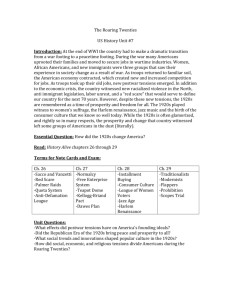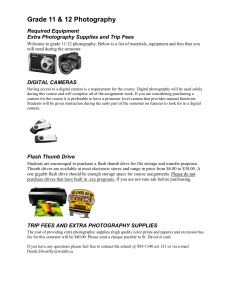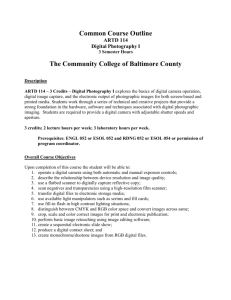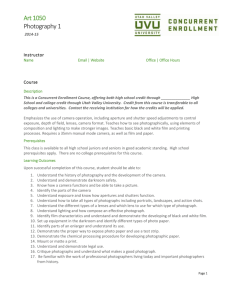ART 151 Syllabus - California State University, Northridge
advertisement
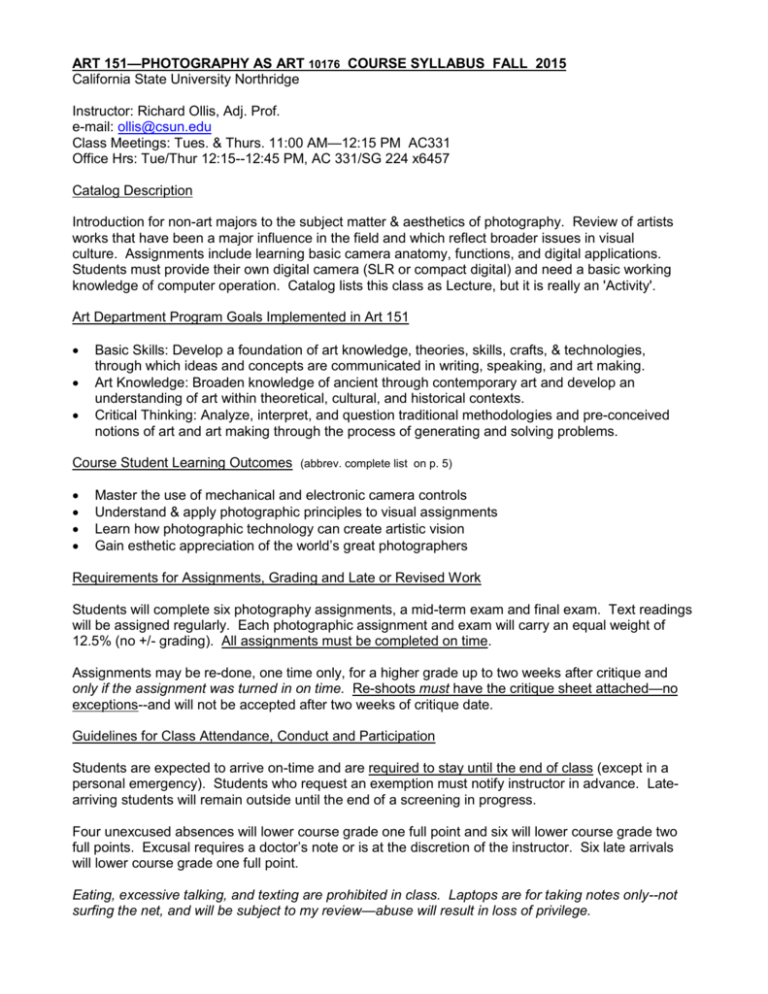
ART 151—PHOTOGRAPHY AS ART 10176 COURSE SYLLABUS FALL 2015 California State University Northridge Instructor: Richard Ollis, Adj. Prof. e-mail: ollis@csun.edu Class Meetings: Tues. & Thurs. 11:00 AM—12:15 PM AC331 Office Hrs: Tue/Thur 12:15--12:45 PM, AC 331/SG 224 x6457 Catalog Description Introduction for non-art majors to the subject matter & aesthetics of photography. Review of artists works that have been a major influence in the field and which reflect broader issues in visual culture. Assignments include learning basic camera anatomy, functions, and digital applications. Students must provide their own digital camera (SLR or compact digital) and need a basic working knowledge of computer operation. Catalog lists this class as Lecture, but it is really an 'Activity'. Art Department Program Goals Implemented in Art 151 Basic Skills: Develop a foundation of art knowledge, theories, skills, crafts, & technologies, through which ideas and concepts are communicated in writing, speaking, and art making. Art Knowledge: Broaden knowledge of ancient through contemporary art and develop an understanding of art within theoretical, cultural, and historical contexts. Critical Thinking: Analyze, interpret, and question traditional methodologies and pre-conceived notions of art and art making through the process of generating and solving problems. Course Student Learning Outcomes (abbrev. complete list on p. 5) Master the use of mechanical and electronic camera controls Understand & apply photographic principles to visual assignments Learn how photographic technology can create artistic vision Gain esthetic appreciation of the world’s great photographers Requirements for Assignments, Grading and Late or Revised Work Students will complete six photography assignments, a mid-term exam and final exam. Text readings will be assigned regularly. Each photographic assignment and exam will carry an equal weight of 12.5% (no +/- grading). All assignments must be completed on time. Assignments may be re-done, one time only, for a higher grade up to two weeks after critique and only if the assignment was turned in on time. Re-shoots must have the critique sheet attached—no exceptions--and will not be accepted after two weeks of critique date. Guidelines for Class Attendance, Conduct and Participation Students are expected to arrive on-time and are required to stay until the end of class (except in a personal emergency). Students who request an exemption must notify instructor in advance. Latearriving students will remain outside until the end of a screening in progress. Four unexcused absences will lower course grade one full point and six will lower course grade two full points. Excusal requires a doctor’s note or is at the discretion of the instructor. Six late arrivals will lower course grade one full point. Eating, excessive talking, and texting are prohibited in class. Laptops are for taking notes only--not surfing the net, and will be subject to my review—abuse will result in loss of privilege. Art 151 Syl. Fall 2015 p. 2 Students are strongly encouraged to ask questions and participate in discussions & critique sessions. Equipment and Supplies Digital SLR or compact camera with full manual controls, zoom lens, memory card & 6 CD’s. or 35mm SLR Film Camera; full manual controls with 50mm or zoom lens. Film: 35mm color transparency/reversal/slides (see p. 5) with notebook viewing sleeves. No color negative film or black & white film of any type allowed. Viewing magnifier (hand-held or 8x loupe) is highly recommended for checking your work. CD’s must be labeled with permanent marker, on the disc, with full name and assignment number, in an appropriate sleeve or case. Home-made covers will not be accepted, will be returned as a late submission and will be ineligible for a re-shoot. Read it and believe it. A tripod, while not required, is very strongly recommended. Basic ‘Point-and-Shoot’ cameras are strictly prohibited for use in this class. Required Text: A Short Course in Digital Photography, 2011, London & Stone (available for rent in Matador bookstore or Amazon.com) Course Outline and Assignment Schedule (subject to revision) Aug. 25 Class 1 Course introduction and assignments overview Equipment Requirements: How to select a camera Reading: SCDP p. 2-10, 12-15, 26-27 SCP p. 3-9, 16-19, 26-27 Aug. 27 Class 2 Basic camera anatomy, functions and controls White balance, focus, exposure and menu settings Reading: SCDP p.51-55, 58-69 SCP p.55-59, 67-73, 76-83 Sept. 1 Class 3 Exposure theory and practice, types and uses of light meters Alternate metering modes and applications Reading: SCDP p.29-39, 46-47 SCP p.29-39, 46-47 Sept. 3 Class 4 Lenses: focal length, lens speed and visual perspective F-stops and shutter speeds and film latitude Asn. #1: Basic Camera and Exposure Tests Due: Sept. 17 Reading: SCDP p.20-25 SCP p.24-25 Sept. 8 Class 5 Exposure equivalents, bracketing and meter override Seeing the Unseen--Photography as Science and Art Evaluating Images: Eadweard Muybridge and Dr. Edgerton Reading: SCDP p.147-151, 156-159 SCP p.181-185 190-193 Sept. 10 Class 6 Elements of composition, framing, and types of shots ISO film/sensor speed, image quality and applications Evaluating images: Cartier-Bresson—The Precise Moment Due: Student Agreement Forms Sept. 15 Class 7 Workday: attendance optional--instructor in classroom Camera workshop and Asn. #1 review as needed Art 151 Syl. Fall 2015 Sept. 17 Class 8 Due: Asn. #1 Color temperatures of light: natural and artificial sources White balance choices and color correction Sept. 22 Class 9 Asn. #1 Critique and discussion Reading: SCDP p.128-137 SCP p.130-139 Sept. 24 Class 10 Natural light: direction, quality and time of day Asn. #2: Natural Light: Buildings & People Due: Oct. 8 Camera support: equipment and techniques Sept. 29 Class 11 Photography as an Expression of Humanity Evaluating images: Diane Arbus, Barbara Morgan and Walker Evans Reading: SCDP p,164-167 SCP p.198-201 p. 3 Oct. 1 Light: as source, object and subject—creative uses of light Class 12 Asn. #6: Light As the Subject Due: Dec 3 (no lates/reshoots allowed) Different worlds: Landscapes and Cityscapes Evaluating images: Ansel Adams, Wynn Bullock and Harry Callahan Oct. 6 Workday: attendance optional—instructor in classroom Class 13 Asn. #2 and reshoot work review Reading: SCDP p.16-19, 154-155 SCP p.20-21, 188-189 Oct. 8 Due: Asn. #2 Class 14 Camera and subject motion, blur and shutter speed Asn. #3: Motion Blur & Pan Action Due: Oct. 22 Due: Asn. #1 Reshoots Oct. 13 Class 15 Asn. #2 Critique and discussion Mid-term Exam review Oct. 15 Class 16 Mid-term Exam (date subject to change) Oct. 20 Workday: attendance optional—instructor in classroom Class 17 Asn. #3 and reshoot work review as needed Oct. 22 Class 18 Due: Asn. #3 Photography as Landscapes of the Mind Evaluating images: Jerry Uelsmann, Edward Weston and Minor White Mid-term exam discussion Oct. 27 Class 19 Asn. #3 Critique and discussion Due: Asn. #2 Reshoots Reading: SCDP p.20-25, 40, 42-45, 152-153 SCP p.22-23, 40, 42-45, 186-187 Oct. 29 Depth-of-field: concept, controls and applications Class 20 Asn. #4: Depth-of-Field Due: Nov. 12 Nov. 3 Class 21 Photographic Persona—Speaking Without Words Evaluating images: Arnold Newman, Annie Liebowitz & Duane Michals Reading: SCDP p.35, 138-139, 160-163 SCP p.35, 140-141, 194-197 Art 151 Syl. Fall 2015 p. 4 Nov. 5 Class 22 Portraiture: natural light, composition and skin tone Asn. #5 Portraits: Faces & Light Due: Nov. 19 Nov. 10 Class 23 Workday: attendance optional—instructor in classroom Nov. 12 Class 24 Due: Asn. #4 In-camera digital information: meta-data and histograms Digital work flow fundamentals Due: Asn. #3 Reshoots Nov. 17 Class 25 Workday: attendance optional—instructor in classroom Nov. 19 Class 26 Due: Asn. #5 Asn. #4 Critique and discussion Reading: SCDP p. 48-49, 56-57, 124-125 SCP p. 50-53, 156-157, 162-163 Nov. 24 Class 27 Asn. #5 Critique and discussion Nov. 26 --- Thanksgiving Holiday --- Dec. 1 Class 28 Camera filtration: problem solving and creative effects The electronic darkroom: digital technologies Dec. 3 Class 29 Due: Asn. #6 (no lates/reshoots allowed) Due: Asn. 4 Reshoots Demo: fundamentals of image manipulation Dec. 8 Class 30 Asn. #6 Critique and discussion Final Exam review Due: Asn 5 reshoots Dec. Final Exam 10:15—12:15 Be prompt--late arrivals (10:30) will forfeit the exam. Photography Supply Stores Freestyle Photo 5124 West Sunset Boulevard Hollywood 323.660.3460 Samy’s Camera 431 South Fairfax Avenue Los Angeles 323.938.2420 Bel-Air Camera 10295 Kinross Avenue Westwood 310.208.5150 Woodland Hills Camera whcamera.com Woodland Hills 818.347.2270 35mm slide films: Fuji Fujichrome Provia 400 ISO (Bel-Air) Fuji Fujichrome Velvia 100 ISO Rollei Digibase CR200 ISO (Freestyle, non-D X Coded) Digital File Sizes (jpeg): ‘Email’, ‘Medium’, ‘1024 pixels’, ‘72dpi@9x12’, ‘640x480’ or ‘L’ Art 151 Syl. Fall 2015 p. 5 Photo Lab for E-6 Processing Icon iconla.com 5450 Wilshire Blvd. Los Angeles 323.933.1666 General Education Student Learning Outcomes in Art 151: Identify and actively engage in behaviors conducive to individual health, well-being, or development, and understand the value of maintaining these behaviors throughout the lifespan. Identify and apply strategies leading to health, well-being, or development for community members of diverse populations. Apply the knowledge and skills of science and technology and evaluate how they impact individuals, the community, and/or society. Art Department Student Learning Outcomes in Art 151 Understand and apply the elements and principles of design as they relate to photography’s ability to impose a frame upon the three-dimensional world and translate it into two dimensions. Acquire and apply basic photography knowledge and skills by using analog and/or digital photographic platforms Acquire knowledge of the history of photography and contemporary photography by looking at other artists’ photographs. Analyze photographs, both verbally and written, through critique and self-reflection. Approach image making from a conceptual perspective by using the camera’s frame to create content. Students with Disabilities Students with disabilities must register with the Center on Disabilities and complete a services agreement each semester. Staff within the Center will verify the existence of a disability based on the documentation provided and approve accommodations. Students who are approved for test taking accommodations must provide a proctor form to their faculty member signed by a counselor in the Center on Disabilities prior to making testing arrangements. The Center on Disabilities is located in Bayramian Hall, room 110. Staff can be reached at (818)677-2684. Course Schedule Notes: _________________________________________________________ ______________________________________________________________________________ ______________________________________________________________________________ ______________________________________________________________________________ ______________________________________________________________________________ ______________________________________________________________________________ ______________________________________________________________________________ ______________________________________________________________________________ ______________________________________________________________________________ ______________________________________________________________________________ (cut here) ART 151 MANDATORY STUDENT AGREEMENT FORM I have read, and understand, all Art 151 course syllabus & guidelines requirements for assignments, due dates, grade & attendance penalties and proper classroom behavior. Name: Signed: (print) Please complete and return by the third week of class Date:
